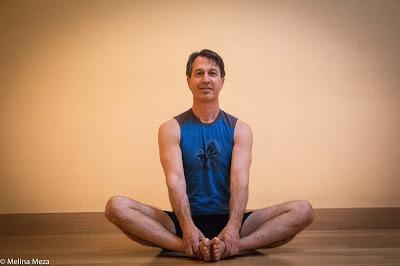 On my first visit to India a bit over 10 years ago, I was thrilled to see an actual cobbler on the streets of Chennai, sitting on the ground with a comfortable posture, holding a tool between his feet, as he worked the shoe he held in his hands. An image to inspire our own explorations of Cobbler’s pose (Baddha Konasana).
On my first visit to India a bit over 10 years ago, I was thrilled to see an actual cobbler on the streets of Chennai, sitting on the ground with a comfortable posture, holding a tool between his feet, as he worked the shoe he held in his hands. An image to inspire our own explorations of Cobbler’s pose (Baddha Konasana).Cobbler’s pose is an excellent pose for stretching your inner thighs, improving the range of motion of your hip joints and, in the forward fold variations, for stretching your back muscles. You can use it to prepare for more advanced seated poses that require openness of the hips, such as Lotus (Padmasana) and Half Lotus (Arda Padmasa), as well as for standing poses that need good inner thigh length, such as Warrior 2 pose (Virabradhrasana 2) and Extended Side Angle pose (Utthita Parsvokanasana). Cobbler's pose works well as counter-pose for Hero pose (Virasana) and most symmetrical backbends, as it takes your thighbones in the opposite direction. It can also strengthen the back muscles in those who tend be slouchers!
I prescribe this pose for:
- Tight hips
- Tight inner thighs (adductor muscles)
- Stiff knees (a good alternative for Hero pose, as Cobbler’s pose is non-weight bearing)
- Improving poor posture
- Quieting the nervous system
- Pregnant women (makes room for the belly in later stages)
1. Classic Pose
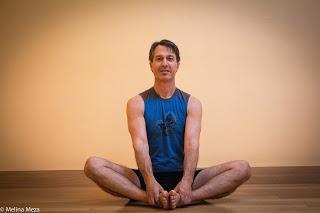 Start by coming into to a comfortable simple Seated Crossed-Legs position (Sukhasana). Now move your knees apart until you can bring the soles of your feet together, with your feet about 12-18 inches from your pubic bone and the baby toe sides of your feet resting on the floor. You can press the soles of your feet together or you can let the inner edges of your feet drop open, like a hardbound book opening on its spine. Try each foot variation and notice its effects on the opening of your hips and overall sensation in your legs. Notice if your knees drop below the level of your high waist. If they don’t, try one of the supported versions below. Rest your hands on your knees or hold your ankles or feet, whichever is more comfortable for you.
Start by coming into to a comfortable simple Seated Crossed-Legs position (Sukhasana). Now move your knees apart until you can bring the soles of your feet together, with your feet about 12-18 inches from your pubic bone and the baby toe sides of your feet resting on the floor. You can press the soles of your feet together or you can let the inner edges of your feet drop open, like a hardbound book opening on its spine. Try each foot variation and notice its effects on the opening of your hips and overall sensation in your legs. Notice if your knees drop below the level of your high waist. If they don’t, try one of the supported versions below. Rest your hands on your knees or hold your ankles or feet, whichever is more comfortable for you.Next, create an internal lift from your sitting bones through you spine and up towards the crown of your head. If your spine lengthens easily and you don’t sense any rounding of your lower back, then this version is good for you. Finally, create length from your inner groin crease along an imaginary inseam to the inner knees. Maintain the spinal lift and the inner thigh length throughout the pose. Stay in the pose for 1-2 minutes initially, gradually working up to longer holds. To come out of the pose, use your hands to bring your bent knees up to center, and then release your legs out in front of you into Staff pose (Dandasana). Or, simple move back into Seated Crossed Legs pose (Sukasana).
2. Propping Hips and/or Knees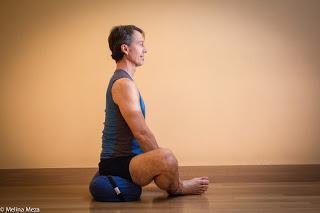 This version is great for those with stiff, rounded spines and stiff, tight hips, who, in the classic position, find that your knees are at or above the high waist area and are possibly even be painful in position. You can use any number of props to sit on:
This version is great for those with stiff, rounded spines and stiff, tight hips, who, in the classic position, find that your knees are at or above the high waist area and are possibly even be painful in position. You can use any number of props to sit on:
- a thin, folded blanket
- a double-folded blanket to provide a higher lift
- the low height of a block, if you prefer a firmer surface=
- a bolster if that feels best
To prop your knees, choose props, whether folded blankets or blocks, that are high enough to allow your knees to rest easily onto them. Propping this way can in and of itself release held tension around your hips.
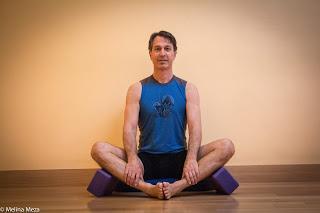 If you have only one side that rides high, try propping both sides high enough so both sides are even. Try also using a prop on just the higher side, especially if that knee is painful. Then use the most comfortable propping for you.
If you have only one side that rides high, try propping both sides high enough so both sides are even. Try also using a prop on just the higher side, especially if that knee is painful. Then use the most comfortable propping for you.The other actions and timing are the same as in the Classic version.
3. Back Support
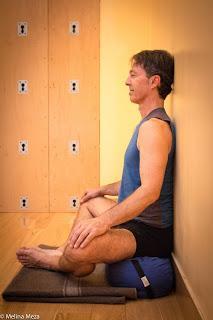 This version is good for who have trouble maintaining a good lift in the spine and tend to fatigue quickly in this area. The wall can provide both support and sensation feedback to help get a more even lift up from ground to head. It can also be a nice version if you are just really. It could also be good variation to use for longer meditations or pranayama practice.
This version is good for who have trouble maintaining a good lift in the spine and tend to fatigue quickly in this area. The wall can provide both support and sensation feedback to help get a more even lift up from ground to head. It can also be a nice version if you are just really. It could also be good variation to use for longer meditations or pranayama practice. Start by sitting in Seated Crossed Legs pose with your back near a wall, and then scoot your buttocks as close to the wall as you can, leaning slightly forward from the hips. Then, roll your spine up to touch the wall and bring your legs into Cobbler’s pose as in the classic version. Ideally, you will feel the middle and upper back contacting the wall with a small space between your lower back and the wall. If you need to, you can prop your hips and knees as in version 2.
The other actions and timing are the same as in the Classic version.
4. Cobbler’s Forward Bend
This version (sorry, no photo!) creates more stretch and openness in your hip joints and the spinal muscles of your back.
Start by coming into Cobbler’s pose as in any of the first three versions. Hold onto your ankles or your feet, whichever is easier (this may depend on your arm length). Next, begin to fold forward, initially tipping from your hips until you feel the pelvis stops rolling forward. From there, mindfully let your spine gently round forward without pulling your spine down with your arms.
Once you arrive at a place where you feel stretch sensations around your hips, buttocks, hamstrings and/or lower back, stay in that position for 30 seconds or so before slowly coming back up to sitting upright. Gradually work you way up to 90-second holds to create longer lasting stretch to these areas. If you experience knee or back pain in the pose, come out immediately and have your local teacher check your set up.
To come out of the pose, first come up out of the forward bend and then move into Staff pose or Seated Crossed Legs pose as instructed above.Subscribe to Yoga for Healthy Aging by Email ° Follow Yoga for Healthy Aging on Facebook ° Join this site with Google Friend Connect

